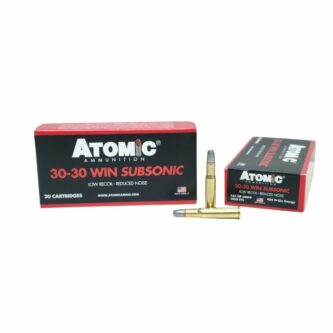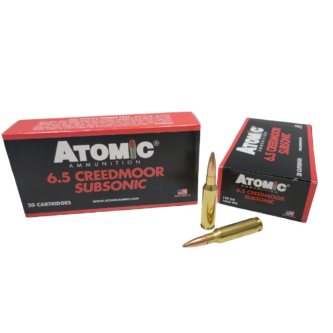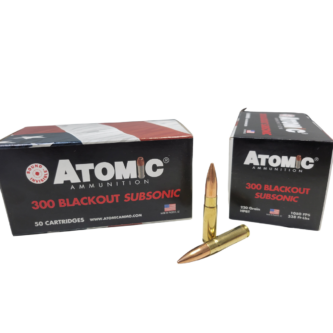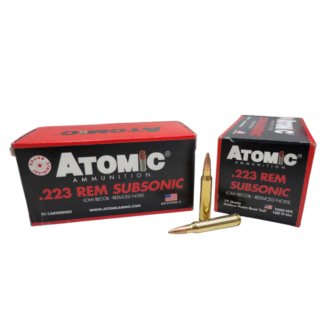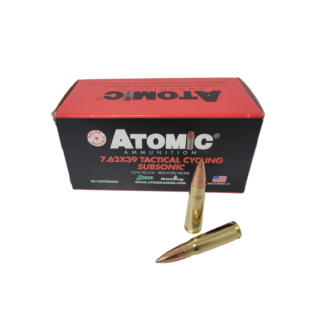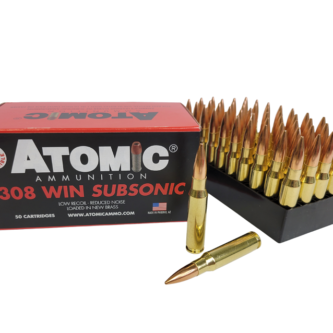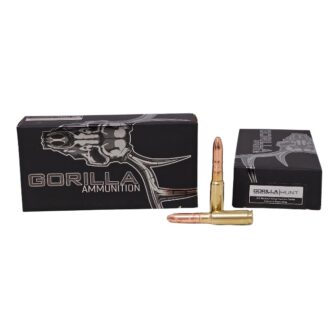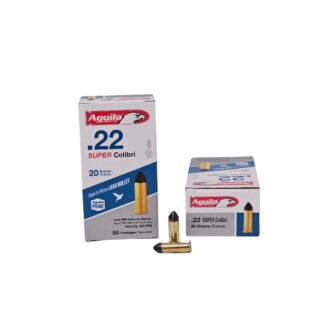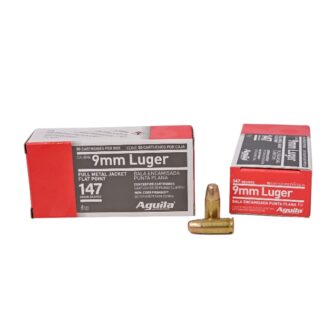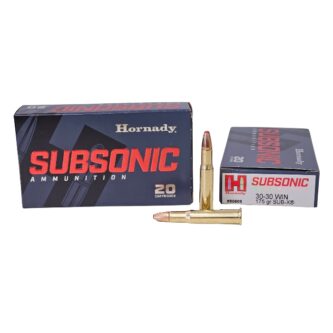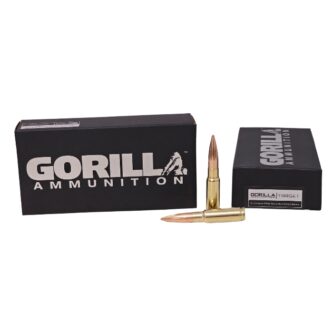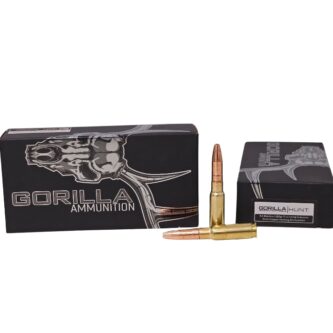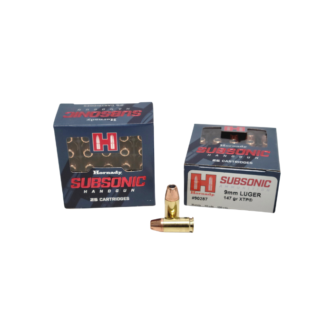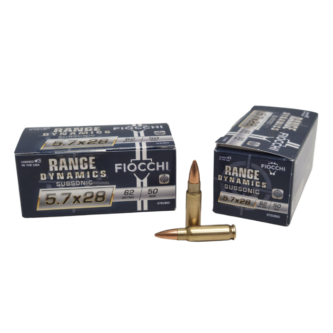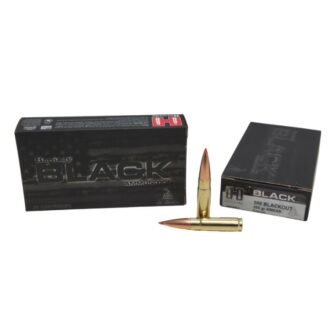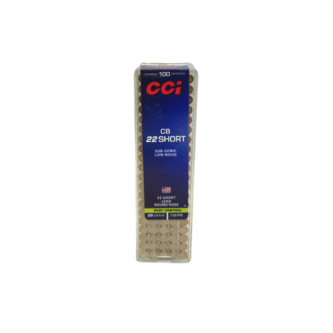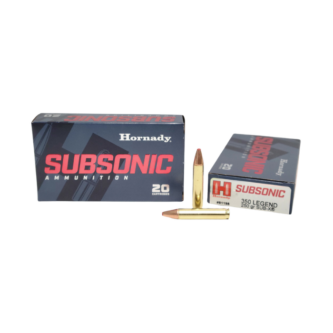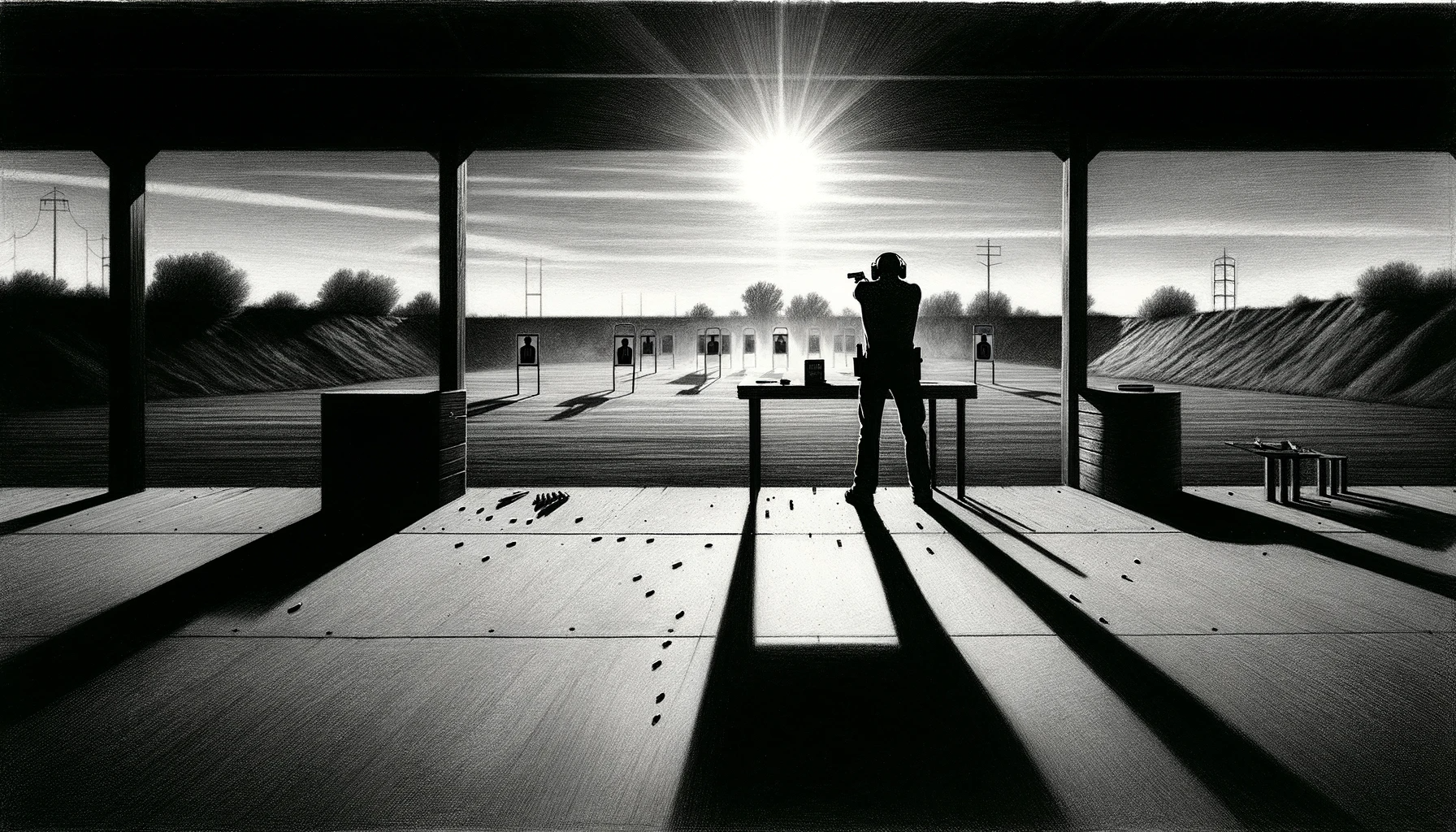
Subsonic rounds hold a unique and intriguing position when it comes to shooting. For many shooters, the term ‘subsonic ammunition’ evokes a sense of mystery and specialized function, differentiating it significantly from standard ammunition. But what exactly sets subsonic ammo apart, and why has it become a topic of interest for gun enthusiasts, hunters, and tactical professionals alike?
Subsonic ammunition is designed to operate at velocities below the speed of sound, which is approximately 1,125 feet per second at sea level. This key characteristic is what fundamentally distinguishes it from standard, supersonic ammunition. While most traditional bullets travel faster than the speed of sound, creating a small sonic boom known as a ‘sonic crack’, subsonic ammunition quietly undercuts this threshold. The result is a significantly quieter shot, a feature that, when paired with a suppressor, reduces the noise level of a gunshot to a mere whisper. For more details on the definition and physics of subsonic ammo, you can check our out entire write-up on subsonic vs. supersonic vs. transonic ammo or check out our ammo education page.
Shop Atomic Subsonic Ammunition
Atomic specializes in subsonic ammunition and is highly recommended by the KIR team.
This quieter performance of subsonic ammunition does not just make for a more pleasant shooting experience; it opens up new possibilities in various shooting disciplines. From covert military operations to discreet pest control, and even recreational shooting where noise reduction is appreciated, the applications of subsonic rounds are as varied as they are valuable.
It’s essential to understand both the capabilities and limitations of subsonic ammunition. This knowledge not only enhances safety and effectiveness but also ensures that each shooter chooses the right ammo for their specific needs. Let’s explore the nuances of subsonic ammunition and uncover why it has become an essential knowledge area for shooters around the globe.
Why Are You Considering Shooting Subsonic?
Before diving into the world of subsonic ammunition, it’s crucial to understand why it might be the right—or-wrong choice for your shooting needs. Subsonic ammo has gained popularity for several valid reasons, but it’s also shrouded in misconceptions and sometimes chosen for the wrong purposes.
Valid Reasons for Using Subsonic Ammo:
- Noise Reduction: The most apparent advantage of subsonic ammunition is its reduced noise level, especially when used with a suppressor. This feature is invaluable in tactical scenarios where stealth is paramount, and in hunting, where a quiet shot can mean the difference between success and failure.
- Recoil Management: Subsonic rounds typically have less recoil compared to standard ammunition, making them an excellent choice for novice shooters, those sensitive to recoil, and for situations where rapid follow-up shots are necessary.
- Specialized Hunting and Pest Control: In hunting, particularly in urban or suburban areas where noise can be a concern, subsonic ammo offers an effective solution. It’s also ideal for pest control, as it minimizes disturbance to the surrounding environment.
Misconceptions and Unnecessary Reasons for Choosing Subsonic Ammo:
- Assuming ‘Quieter’ Means ‘Silent’: It’s a common misconception that subsonic ammo is completely silent. While it significantly reduces noise, especially with a suppressor, it’s not completely silent. Understanding this distinction is essential in setting realistic expectations.
- Inappropriate Calibers for Subsonic Use: Not all calibers are well-suited for subsonic use. Some shooters mistakenly think that simply loading any cartridge to subsonic speeds will yield good results, which isn’t always the case. Certain calibers are better optimized for subsonic performance.
- Overestimating Capabilities: While subsonic ammo is excellent for certain applications, it’s not a one-size-fits-all solution. It has limitations in range and stopping power compared to standard ammunition. Choosing subsonic rounds for long-range shooting or for taking down large game can lead to disappointing results.
When considering whether subsonic ammunition is right for you, it’s important to assess your specific needs and understand both the benefits and limitations of these rounds. Subsonic ammo can be a valuable tool in your arsenal when used correctly, but it’s not always the best choice for every shooter or every situation. By dispelling myths and focusing on its practical applications, you can make an informed decision about incorporating subsonic ammunition into your shooting practice.
What is All the Hype About?
In recent years, there has been a noticeable resurgence in the popularity of subsonic ammunition, a trend that can be largely attributed to the increasing use and accessibility of suppressors. This renewed interest isn’t just a passing fad; it’s rooted in the tangible benefits that subsonic ammo offers, especially when paired with a suppressor.
Link to Suppressor Use:
- Suppressor Compatibility: The rise in the use of suppressors among civilian shooters has played a pivotal role in the growing popularity of subsonic ammunition. Suppressors, designed to reduce the sound of gunfire, work exceptionally well with subsonic rounds, as these rounds don’t produce the sonic crack of supersonic bullets. This combination results in an incredibly quiet shooting experience. Furthermore, technology behind suppressors has also improved and this is leading to “movie-like” capabilities in some cases.
- Legal Changes: Changes in legislation in various regions, making suppressors more accessible to the general public, have also contributed to this trend. As more shooters gain the ability to legally own suppressors, the demand for subsonic ammunition naturally increases.
Advantages of Subsonic Ammunition:
- Noise Reduction: The most significant advantage of subsonic ammunition is its reduced noise level. By traveling slower than the speed of sound, subsonic bullets eliminate the sharp crack that accompanies supersonic bullets, making them ideal for discreet operations and reducing noise pollution.
- Recoil Management: Subsonic rounds generally have less recoil compared to their supersonic counterparts. This reduction in recoil makes for a more comfortable shooting experience, allows for better control, and is particularly beneficial for new or recoil-sensitive shooters.
- Versatility: Subsonic ammunition is not only limited to tactical use; it’s also becoming increasingly popular in hunting, especially in populated areas where noise can be a concern. Additionally, it’s a preferred choice for recreational shooters who enjoy a quieter shooting experience.
Why the Hype Now?
- Technological Advances: Recent advancements in ammunition technology and suppressors has improved the performance of subsonic rounds, making them more reliable and effective.
- Cultural Shift: There’s also a cultural shift towards more personalized and specialized shooting experiences. Shooters are exploring various aspects of firearms, including different types of ammunition, to enhance their experience.
The resurgence in subsonic ammunition’s popularity is a response to its harmonious relationship with suppressors, combined with its inherent advantages. As the shooting community continues to evolve, subsonic ammunition stands out as a key player in shaping the future of shooting sports, hunting, and tactical operations.
Check out some videos of subsonic ammo with a suppressor in action:
View this post on Instagram
Ideal Cartridges for Subsonic Loads
Selecting the right cartridge is a crucial step in optimizing the performance of subsonic ammunition. Some cartridges are inherently better suited for subsonic loads, offering an ideal balance between bullet weight, case capacity, and ballistic performance. Here are some of the top choices for both rifle and handgun shooters:
Rifle Cartridges Well-Suited for Subsonic Loads:
- .300 Blackout: Perhaps the most popular choice for subsonic rifle shooters, the .300 Blackout was designed to be highly versatile, capable of handling both subsonic and supersonic loads effectively. Its ability to accommodate heavy bullets makes it an excellent choice for suppressed shooting.
- 7.62x39mm: While most factory ammunition for this caliber is supersonic, the 7.62x39mm can be an excellent subsonic cartridge when loaded appropriately. It’s a solid choice for shooters looking to achieve subsonic performance with a commonly available round.
- .450 Bushmaster, .458 SOCOM, and .45-70 Gov’t: These larger calibers are also well-suited for subsonic loads, especially in hunting applications where stopping power at subsonic velocities is essential.
- .350 Legend: A newer addition to the subsonic lineup, the .350 Legend is gaining popularity for its ability to provide effective subsonic performance, particularly in straight-wall cartridge hunting zones.
Handgun Cartridges for Subsonic Loads:
- .45 ACP: The .45 ACP is naturally subsonic, making it an excellent choice for suppressed shooting. Its heavier bullets provide effective performance without crossing the sonic threshold.
- 9mm: While standard 9mm loads are typically supersonic, heavier bullet options like 147-grain rounds are commonly subsonic. These heavier loads offer a quieter shooting experience, especially when paired with a suppressor.
Choosing the Right Subsonic Ammunition: When selecting a subsonic cartridge, consider the intended use—be it tactical, hunting, or recreational shooting. For rifle shooters, cartridges like the .300 Blackout and 7.62x39mm offer versatility and compatibility with many firearm platforms. For handgun shooters, the .45 ACP and heavier 9mm rounds provide a balance of power and discretion. It’s also essential to consider the availability of these cartridges and their compatibility with your firearm and suppressor setup.
The right subsonic cartridge can significantly enhance your shooting experience, especially when noise reduction and recoil management are priorities. Whether you’re a hunter, tactical shooter, or a firearm enthusiast, understanding the nuances of these ideal subsonic cartridges will help you make an informed decision for your specific needs.
Subsonic Use with Suppressors
The synergy between subsonic ammunition and suppressors represents one of the most effective combinations in modern shooting. This pairing significantly enhances the shooting experience by drastically reducing noise levels, making it a favored choice in various scenarios, from tactical operations to discreet hunting and recreational shooting.
Enhanced Noise Reduction:
- Suppressing the Sonic Crack: While suppressors are designed to muffle the explosive noise of a gunshot, they cannot silence the sonic boom created when a bullet breaks the sound barrier. This is where subsonic ammunition comes into play. By staying below the speed of sound, subsonic rounds avoid creating this sonic crack, allowing the suppressor to be much more effective.
- Total Sound Suppression: When combined with a suppressor, subsonic ammunition can reduce the sound of a gunshot to a mere whisper. This level of sound reduction is particularly beneficial in situations where maintaining a low noise profile is crucial, such as in tactical operations or in hunting to avoid spooking game.
Operational Efficiency:
- Increased Stealth: The reduced noise signature of subsonic ammunition and suppressors provides a significant tactical advantage, allowing shooters to operate stealthily. In military and law enforcement scenarios, this can be crucial for the success of covert operations.
- Hunting Advantages: For hunters, using subsonic ammunition with a suppressor not only minimizes disturbance to wildlife but also contributes to a more ethical hunt by reducing the likelihood of scaring off the target after a missed first shot.
Recreational Shooting Benefits:
- Comfortable Shooting Experience: Recreational shooters often prefer this combination for the comfort it provides. The reduced noise and recoil make for a more enjoyable shooting experience, especially in enclosed spaces like indoor ranges.
- Neighborly Relations: In areas where noise can be an issue, such as near residential neighborhoods, using subsonic ammo with a suppressor can help maintain good relations with nearby residents by minimizing sound pollution.
The use of subsonic ammunition in conjunction with suppressors represents a significant advancement in shooting technology, offering unparalleled noise reduction and operational stealth. Whether for tactical, hunting, or recreational purposes, this combination maximizes the effectiveness of both the ammunition and the suppressor, leading to a more efficient and enjoyable shooting experience.
Subsonics Are Not Always a Good Choice
While subsonic ammunition offers numerous benefits, there are certain scenarios and technical aspects where it may not be the ideal choice. Understanding these limitations is crucial for safe and effective shooting.
The Importance of Bullet Stabilization:
- Stabilization Challenges: Subsonic bullets, often heavier and slower, require careful consideration regarding stabilization. If a bullet isn’t properly stabilized, it can wobble or tumble, leading to inaccurate shots.
- Risk of Baffle Strikes: Improperly stabilized subsonic bullets pose a significant risk when using suppressors. A destabilized bullet can veer off course and strike the baffles of the suppressor, potentially causing a dangerous malfunction known as a baffle strike.
- Verifying Stability: Before using subsonic rounds in a suppressor, it’s essential to test the ammunition for stabilization. Shoot a few rounds through paper targets at a close range to ensure the bullets are flying straight and true, minimizing the risk of baffle strikes.
Suppressor Compatibility Issues:
- Over-Bored Suppressors: While using an over-bored suppressor (a suppressor with a bore diameter larger than the bullet caliber) is common and effective with supersonic loads, it may not be as effective with subsonic ammunition. This is due to the lower gas pressure generated by subsonic rounds, which may not sufficiently pressurize the suppressor.
- Choosing the Right Suppressor: For optimal noise reduction with subsonic ammo, select a suppressor that closely matches the bullet’s caliber and consider the specific characteristics of the subsonic load being used.
Challenges with Semi-Automatic Firearms:
- Cycling Issues: Many semi-automatic firearms are designed to cycle with the higher pressures generated by supersonic ammunition. Subsonic rounds, with their reduced pressures, may not generate enough force to properly cycle the action in these firearms.
- Manual Cycling and Specific Designs: When using subsonic ammo in standard semi-automatics, be prepared to manually cycle the action for each shot. Alternatively, some semi-auto firearms and specific models are designed to function reliably with subsonic rounds, so consider these options if you frequently use subsonic ammo.
While subsonic ammunition can be highly effective and beneficial in the right context, it requires careful consideration of bullet stabilization, suppressor compatibility, and firearm type. Understanding these factors ensures not only the effectiveness of your shooting experience but also your safety and the longevity of your equipment.
Barrel Twist Rate and Its Importance for Subsonic Ammunition
An often overlooked but crucial factor in the performance of subsonic ammunition is the barrel twist rate of the firearm. Understanding the relationship between twist rate and subsonic rounds is essential, particularly for rifle shooters who are considering or already using subsonic ammunition.
Understanding Twist Rate:
- Twist Rate Defined: The twist rate of a rifle barrel refers to the distance over which the rifling takes to complete one full revolution. A 1:10 twist rate means one complete twist in 10 inches of barrel length.
- Impact on Bullet Stability: Twist rate is critical in stabilizing the bullet as it travels down the barrel and through the air. The right twist rate can significantly impact the accuracy and effectiveness of a shot, especially with subsonic rounds.
Twist Rates for Subsonic Ammunition:
- Faster Twist Rates for Stability: While the slowest common twist rate is typically 1:10, many subsonic rounds, particularly heavier bullets, require faster twist rates (like 1:9, 1:8, or 1:7) for optimal stability and accuracy. This is because heavier bullets, which are common in subsonic loads, need a faster spin to maintain a stable flight trajectory.
- The Case of 8.6 Blackout: An extreme example of this principle is the 8.6 Blackout cartridge, which is designed for an incredibly fast 1:3 twist rate. Due to its large size and the need to maintain trajectory at subsonic speeds, the 8.6 Blackout requires this rapid twist to ensure the bullet remains stable and accurate.
- Primarily for Rifle Rounds: It’s important to note that the consideration of twist rates is mainly applicable to rifle rounds. In the case of pistol and rimfire ammunition, twist rate is generally less of a concern and does not apply to the same extent.
Choosing the Right Twist Rate:
- Compatibility with Subsonic Ammo: When selecting a rifle for subsonic shooting, it’s crucial to consider if the barrel’s twist rate is compatible with the type of subsonic ammunition you plan to use. A mismatch between the bullet weight and the barrel’s twist rate can lead to poor performance and accuracy issues.
- Consultation and Research: If you’re unsure about the compatibility of your rifle’s twist rate with certain subsonic rounds, consult with firearms experts or conduct thorough research. Understanding this aspect can greatly enhance your shooting experience with subsonic ammunition.
In summary, the twist rate of a rifle barrel plays a pivotal role in the performance of subsonic ammunition. Shooters who are keen on using subsonic rounds, especially in rifles, should pay careful attention to ensure that their firearm’s twist rate is suitable for the specific subsonic ammunition they intend to use. This consideration is key to achieving the best possible accuracy and overall shooting performance with subsonic rounds.
Accuracy and Range Limitations
While subsonic ammunition offers numerous benefits, particularly in terms of noise reduction and reduced recoil, it’s important for shooters to be aware of its inherent limitations in range and accuracy. Understanding these constraints is crucial for effectively using subsonic rounds in various shooting scenarios.
Reduced Range:
- Lower Velocity Impact: Due to their lower velocities, subsonic rounds generally have a shorter effective range compared to supersonic ammunition. The slower speed means these bullets lose energy more quickly, limiting their effective distance.
- Trajectory Considerations: Subsonic bullets typically have a more pronounced bullet drop at distances beyond their optimal range. Shooters need to compensate more for bullet drop, which can challenge accuracy, especially at longer ranges.
Impact on Accuracy:
- Short to Medium Range Accuracy: Within their effective range, subsonic rounds can be incredibly accurate. This makes them suitable for applications like close-range hunting, target shooting, and tactical scenarios where long-range shots are not required.
- Challenges in Long-Range Shooting: For long-range shooting, the reduced velocity and increased bullet drop of subsonic ammo can pose significant accuracy challenges. Calculating holdover and windage becomes more critical and difficult, which might not be suitable for all shooters, particularly those new to long-range shooting.
Choosing the Right Application:
- Ideal Scenarios: Subsonic ammunition is most effective in scenarios where stealth is more critical than long-range precision, such as close-range hunting in noise-sensitive environments or tactical operations requiring discretion.
- Understanding Limitations: Shooters must recognize the trade-off between the stealth benefits of subsonic ammunition and its range limitations. Choosing to use subsonic rounds should be based on a clear understanding of the shooting context and range requirements.
While subsonic ammunition offers significant advantages in terms of noise reduction and recoil management, its limitations in range and long-range accuracy are important factors to consider. Shooters should weigh these considerations carefully to ensure that their choice of ammunition aligns with their shooting needs and scenarios. By doing so, they can make the most of the unique qualities of subsonic rounds while managing their inherent limitations.
A Final Word:
Subsonic ammunition stands out as a specialized and highly beneficial choice in specific shooting contexts, offering a unique combination of reduced noise, manageable recoil, and operational stealth. While it’s essential for shooters to appreciate the advantages of subsonic rounds, particularly when paired with suppressors, understanding their limitations in terms of range and accuracy is equally crucial. Whether used for tactical purposes, hunting in noise-sensitive environments, or simply for the enjoyment of a quieter shooting experience, subsonic ammunition requires thoughtful consideration and application. By acknowledging both its strengths and limitations, shooters can effectively integrate subsonic rounds into their arsenal, ensuring a shooting experience that is not only enjoyable and effective but also well-suited to their specific needs and scenarios. As with any aspect of firearms and shooting, knowledge and informed decision-making are key to maximizing the benefits while respecting the capabilities of this unique type of ammunition.
Great Deals on Subsonic Ammo
For shooters intrigued by the distinct advantages of subsonic ammunition, KIR Ammo is your premier destination. We pride ourselves on our extensive selection of subsonic rounds, catering to a wide array of shooting preferences and needs. Our commitment to fast order processing and swift shipping means you get your ammunition quickly and efficiently, without any hassle. At KIR Ammo, we don’t just offer products; we provide an experience backed by exceptional customer service. Our team is dedicated to supporting your Second Amendment rights and ensuring that every purchase aligns with your shooting goals and values. Plus, with our everyday discount prices and some of the best deals on the web, you can trust that you’re getting top-quality ammunition at unbeatable value.
Subsonic Ammo FAQ
- Is it OK to shoot subsonic ammo without a suppressor?
- Yes, it’s perfectly fine to shoot subsonic ammunition without a suppressor. While suppressors enhance the noise reduction benefits of subsonic rounds, these rounds can still be used effectively on their own.
- What’s the difference between subsonic ammo and regular ammo?
- The primary difference lies in the speed of the bullet. Subsonic ammunition travels at a speed below the sound barrier (approximately 1,125 feet per second), reducing the sonic boom effect, while regular ammo typically exceeds this speed.
- Is subsonic ammo really quieter?
- Yes, subsonic ammo is quieter than supersonic ammunition because it doesn’t produce the loud sonic crack associated with bullets breaking the sound barrier.
- Why do people shoot subsonic?
- People shoot subsonic ammo for its reduced noise, lower recoil, and compatibility with suppressors, making it ideal for tactical use, hunting in noise-sensitive areas, and recreational shooting where noise reduction is desired.
- What are the cons of subsonic ammo?
- The drawbacks include reduced range and velocity, lessened kinetic energy at longer distances, and potential cycling issues in some semi-automatic firearms.
- Does subsonic ammo hit harder?
- Not necessarily. While subsonic ammo can be effective at close range, its lower velocity may result in less kinetic energy upon impact compared to supersonic rounds, especially at longer distances.
- What calibers are naturally subsonic?
- Calibers like .45 ACP and some configurations of 9mm and .22 LR are naturally subsonic due to their standard bullet weights and velocities.
- Are subsonic rounds better for home defense?
- Subsonic rounds can be suitable for home defense due to their reduced noise, which is beneficial in a confined space. However, the choice should be based on the specific caliber’s stopping power and the shooter’s comfort with the ammunition.
- Do Navy SEALs use subsonic ammo?
- Navy SEALs and other special forces may use subsonic ammunition in specific tactical operations where stealth and noise reduction are crucial.
- Why is subsonic ammo so expensive?
- Subsonic ammo can be more expensive due to the specialized design, production costs, and lower demand compared to standard ammunition.
- What are the pros and cons of subsonic ammo?
- Pros include reduced noise, lower recoil, and less chance of hearing damage. Cons include reduced range, potential accuracy issues at longer distances, and the need for specific firearms and suppressors to optimize performance.
